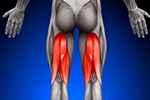The hamstring is a group of four muscles located at the back of the thigh. These include the semitendinosus, semimembranosus, and the long and short head of the biceps femoris, which are responsible for bending the knee and extending the hip.
The term “hamstring injury” refers to injuries that occur to any of these muscles, ranging from a mild strain to a complete rupture. These injuries are common in sports that require quick and explosive movements, such as sprinting, basketball, and football.
Proximal hamstring tears are more specific injuries occurring in the proximal hamstring tendon in the top portion of the hamstring, which attaches the hamstring muscle to the ischial tuberosity (the 'sits' bone). A tear in this region can lead to chronic pain and hinder your walking ability. It may also be more challenging to treat, often requiring proximal hamstring repair surgery to restore mobility.
What Causes Proximal Hamstring Tears?
A proximal hamstring tear typically occurs during physical activities requiring quick, explosive movements, such as running, sprinting, or gymnastics. When the muscle is suddenly stretched beyond its limit, the force can cause fiber failure at the point of attachment or within the muscle itself, resulting in a tear.
What Are the Different Grades of Proximal Hamstring Injuries?
Proximal hamstring injuries are classified according to grades, depending on the symptoms and severity of the damage. During your consultation, your orthopedic specialist will evaluate your injury and assign any of the following grades:
- Grade 1 (Minor Strain): This is the most common form of injury, often associated with mild pain or swelling and little to no loss of function.
- Grade 2 (Partial Tear): The amount of pain associated with a partial tear significantly increases and will typically accompany some loss of function in the hamstring. Some bruising may also appear in the area.
- Grade 3 (Complete Rupture): Also called a complete proximal hamstring tendon avulsion, this grade is assigned when the tendon has completely detached from the bone. It is also accompanied by extreme pain, swelling, significant bruising, and loss of function. Proximal hamstring repair surgery is necessary to reattach the tendon to the bone.
Be on the lookout for pain at the back of the thigh, sometimes associated with an audible popping sound. The sharpness of the pain and the amount of control you have in your leg may determine what grade your injury is.
For instance, minor pain that worsens with movement can be classified as Grade 2. Meanwhile, intense pain when you can’t move your leg at all is a Grade 3 tear.
What are the Symptoms of a Proximal Hamstring Tear?
The symptoms of proximal tendon tears can vary by patient. However, there are some common signs to watch out for to help you identify the issue sooner and get the treatment you need right away. These include the following:
- Sudden sharp pain that worsens with physical activity
- Swelling and bruising in the area
- Pain when sitting or stretching
- Weakness and loss of function in the affected leg
- Muscle spasm
- Limited range of motion
- Cramping
- Difficulty bearing weight
Regardless of the level of pain you experience when you think you have an injury, your best course of action should be to get it looked at immediately. Early hamstring treatment can help minimize pain in the affected area and avoid further damage to the tendon.
How Is a Proximal Hamstring Injury Diagnosed?
Diagnosing a proximal hamstring injury begins with a thorough physical examination by a healthcare professional. As part of the diagnostic process, your attending physician will check for swelling and tenderness in the area and assess the range of motion without pain.
Imaging tests, such as X-rays, MRI scans, or ultrasounds, may be used to visualize the injury and assess the severity of the tear. Finally, they will also ask you about how the injury occurred and your medical history to determine past hamstring issues. All of these pieces of information are essential.
How is Proximal Hamstring Repair Performed?
The treatment process for a proximal hamstring injury will vary, depending on the grade of the tear. For minor strains, physicians will often recommend following the Rest, Ice, Compression, and Elevation (RICE) method to rest and reduce swelling in the affected region.
Higher-grade tears may require a more structured rehabilitation program tailored to your specific injury. Your treatment plan will revolve around surgery and physical therapy to repair and rehabilitate the damaged tendon, which may be any of the following:
- Endoscopic Therapy: An effective and minimally invasive procedure that involves inserting a camera through a small incision in the skin. The surgeon then uses special instruments to repair the tendon.
- Open Hamstring Repair Surgery: This is a more invasive method to treat proximal hamstring tears. It involves making an incision in the leg to gain access to and repair the tendon with sutures.
When Should I Book an Appointment?
Pay attention to any of the abovementioned signs and symptoms of a proximal hamstring tear. If you are experiencing pain in your hamstring region, heard a popping sound, or are unable to work or bear weight on your legs, you should seek help from a medical professional immediately. Even milder symptoms warrant an evaluation to prevent further damage and ensure you receive the appropriate treatment for your injury.
Get Relief From Your Proximal Hamstring Tear Symptoms
Pain in your hamstring, no matter how mild it may be, is always a cause for concern. An untreated hamstring injury may cause more damage to the tendon, which can be even more painful. Worse, it may lead to a total loss of function in your leg. This is why, when dealing with a possible proximal hamstring tear, it is best to seek treatment from a qualified expert.
As a nationally recognized orthopedic surgeon, Dr. Benjamin Domb is a pioneer in advanced new techniques in hip arthroscopy, delivering innovative treatment plans that ensure the best outcome for patients dealing with hip and hamstring pain. Have your hamstring injury evaluated by a nationally recognized orthopedic surgeon and gain access to a comprehensive treatment plan tailored to your specific needs and lifestyle goals.
Contact (833) 872-4477 or complete this form to request an appointment today!





